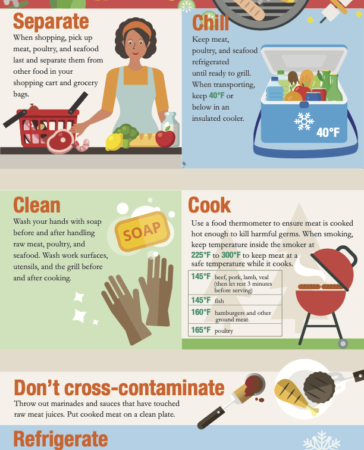July 5th, 2022
The U.S. Department of Agriculture reminds Americans to stay safe when cooking and eating outdoors this summer:
Rates of foodborne illness tend to increase during the summer months because germs grow faster in warmer, more humid weather. People also cook and eat outside, making shortcuts to food safety tempting because they are away from the convenience of soap and running water at the kitchen sink.
The American Academy of Pediatrics explains why kids are especially prone to foodborne illnesses:
One in six people gets sick after eating contaminated food each year. Children who are most likely to become ill are those under age 5 and kids with chronic health problems. Young children have less acid in their stomachs to kill the germs, while those with a weak immune system have a difficult time fighting off harmful organisms in food, according to the Food and Drug Administration (FDA).
Symptoms of food poisoning can include diarrhea, vomiting, stomach cramps, fever, muscle aches, infections, seizures, neurologic problems and even death.
As one might expect, undercooked meats and poultry, foods containing dairy, egg dishes, and contaminated fruit and vegetables are the common sources of foodborne pathogens. The AAP encourages all home chefs to follow these steps to keep summer picnics and barbecues safe for everyone:
Before cooking meat, poultry, fish or other foods, wash your hands and clean any surfaces used to prepare the food.
The Centers for Disease Control and Prevention (CDC) says to keep raw meat, poultry, seafood and eggs separate from other foods so germs don’t spread. Use different cutting boards for different types of food.
Meats should be cooked until they reach a specific temperature inside to kill germs that can make you sick:
• 145 degrees Fahrenheit (F) for whole cuts of beef, veal, lamb and pork, including fresh ham (raw);
• 145 degrees F for fish with fins, or cook until the flesh is opaque;
• 160 degrees F for ground meats, such as beef and pork;
• 165 degrees F for all poultry, including ground chicken and turkey; and
• 165 degrees F for all leftovers and casseroles.
The CDC recommends using a food thermometer to ensure the proper temperature has been reached.
Put leftovers in a refrigerator or freezer right away to prevent bacteria from multiplying. The temperature inside refrigerators should be 40 degrees F or below, and freezers should be 0 degrees F or below.
A hot grill is good for more than just cooking meats:
When grilling fruits and vegetables, there are a few things to keep in mind:
• Marinating vegetables is a great way to infuse flavor and moisture into your vegetables before cooking on the grill – but never use leftover marinade that has been used for raw meat, poultry or seafood items.
• While fruits and vegetables may not have to reach a safe minimum internal temperature the same way meat, poultry and seafood do, different fruits and vegetables will have different cooking times. Thicker cut fruits and vegetables, and denser vegetables (such as potatoes), will take longer to cook. Because of the high heat of the grill, this can result in a thoroughly cooked outside but an uncooked inside of the fruit or vegetable. For more even cooking, cut fruits and vegetables into smaller pieces and use a medium to low grill temperature. For thinner sliced fruits and vegetables, turn them often and pay attention to when they may be done so you don’t end up with burnt fruits and veggies.
Read more from the USDA, FDA, and CDC about the best ways to prevent foodborne illnesses here.




































